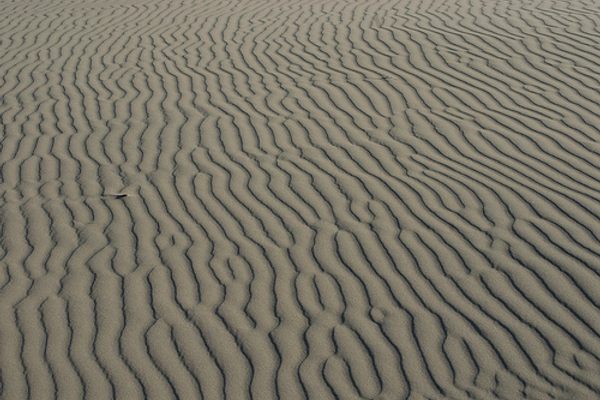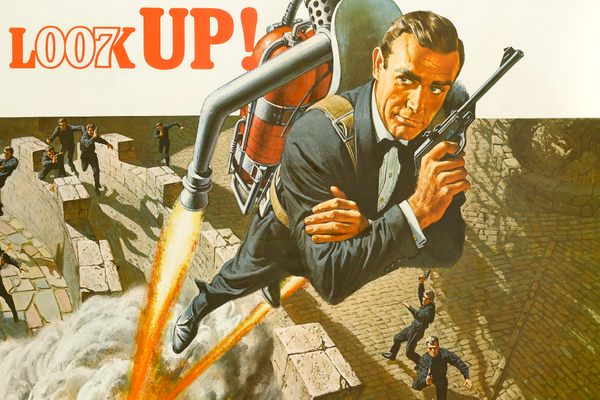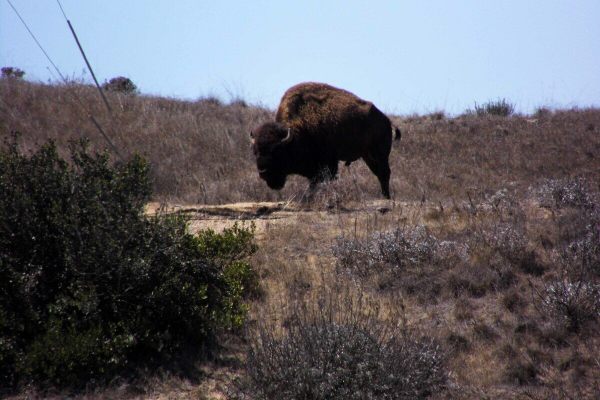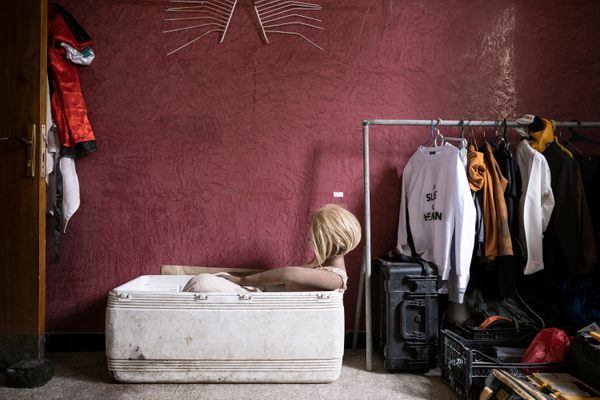After the Wrap: The Post-Shooting Life of Sixteen Film Sets
A big part of any film’s budget concerns the set — finding and renting a location, altering its look, and sometimes building the whole thing from scratch. Usually the crew strikes everything after filming wraps, but sometimes they leave things in place for future films, or at the property owner’s request, or because they ran out of money for the demolition. Here’s what happened to 16 sets after filming folded.
HOBBITON
Matamata, New Zealand
Hobbiton, New Zealand (photograph by Anup Shah)
New Zealand sheep farmer Dean Alexander had never heard of Tolkien’s Lord Of The Rings trilogy before 1998, when director Peter Jackson approached him about filming on part of his property. With Alexander’s blessing, Jackson turned 12 acres of the family ranch into Hobbiton, the idyllic village from which Frodo Baggins sets off on his quest.
Inside Hobbiton (photograph by Rob Chandler)
The Lord of The Rings set was temporary, but tourist attention from fans brought Alexander to restore some of the “hobbit holes” for visitors, and when Jackson returned to reconstruct the set for The Hobbit trilogy, he built it to stay. Today the Alexanders offer tours of “the real Middle Earth” — the hobbit-holes and gardens of Hobbiton, topped off with lunch at the film’s Green Dragon Inn — in addition to maintaining their sheep farm.
A “Hobbit Hole” (photograph by Anup Shah)
SPECTRE
North of Montgomery, Alabama
Spectre in 2006 (photograph by sunsurfr/Flickr user)
In director Tim Burton’s grown-up fairy tale Big Fish, Ewan McGregor is a young traveler who discovers the town of Spectre hidden in the Alabama woods. It’s a tempting spot to settle — everyone is friendly, there are no roads, and the town sits on grass so lush that everyone goes barefoot — but McGregor’s character still decides to move on.
Burton also moved on after filming wrapped in 2003, leaving the houses, stores, and chapel of Spectre in place for other wanderers to find (with permission from the property owner). Sadly, recent adventurers report that all but the chapel and a house or two have collapsed.
POPEYE VILLAGE
Malta
Popeye Village (photograph by Edwinb/Wikimedia)
Robert Altman’s 1980 film adaptation of the comic Popeye suffered at the box office, but the nation of Malta has done very well with the film’s set, turning it into the Popeye Village theme park.
The park preserves the original 20 buildings constructed for Popeye’s “Sweethaven” setting, and adds a museum devoted to the movie’s history. It also stages shows featuring Popeye and Olive Oyl, and scenic boat tours of the village and its bay.
Walking through Popeye Village (photograph by Ploync/Wikimedia)
NAMI AND JEJU ISLANDS
South Korea
Set for “The Legend” (photograph by Thddbwnd/Wikimedia)
In South Korea, fans of the 2002 Korean romantic television drama Winter Sonata flock to Nami Island, home to the bulk of the show’s location shoots. Winter Sonata’s creators used existing locations as-is, but the tourist attention caught the eye of several shows being filmed on nearby Jeju Island, who built their sets with an eye to leaving them behind as destinations after filming wrapped.
The biggest set was for a 2007 series called Taewangsasingi (The Legend), a period drama with a lavish city set including a king’s palace, inns, markets, and houses. Elsewhere on Jeju is a hotel set from Swallow the Sun, a splashy soap opera. Both sets drew an initial flood of tourists, but attendance soon fizzled. Now the sets are abandoned and residents consider them eyesores. Portions of the set for Taewangsasingi have been demolished, but Swallow the Sun’s hotel remains intact — visitors report that many of its props are even still in place.
Nami Island (photograph by whyyan/Flickr user)
FIELD OF DREAMS
Dubuque County, Iowa
Field of Dreams in 2003 (photograph by Joel Dinda)
20th Century Fox built it; the tourists have come. The iconic baseball-diamond-in-a-cornfield from Field of Dreams was built astride two family’s farms. Most of it was on the Lansing family farm, but a chunk of the right field was on property belonging to their neighbors the Ameskamps.
The Ameskamps turned their parcel back into farmland for a while, but the Lansings preserved their portion and opened it up to tours, set up a gift shop, and organized a baseball team to play demonstration games. The Ameskamps soon cleared their parcel back up and ran their own competing gift shop until 2007, when they sold the right field to the Lansings. The site is now celebrating its 25th anniversary of business in 2014, complete with weekly demonstration games featuring its team, “The Ghost Players.”
Dual Field of Dreams gift shop signs (photograph by Madmaxmarchhare/Wikimedia)
THE AFRICAN QUEEN
Key Largo, Florida
The African Queen (photograph by Luke J. Spencer)
This famous boat was actually called the Livingstone when first built in 1912, and under that moniker spent 40 years as a charter and cargo boat in East Africa. Director John Huston later “cast” the boat in the title role of his 1951 film The African Queen, the story of a charter boat captained by Humphrey Bogart, co-starring Katherine Hepburn as a missionary.
Under its more legendary name, The African Queen returned to work as a charter boat, passing through many hands and through many docks, ending up abandoned in the 1960s in Cairo before relocating to Key Largo, Florida, in the 1980s. There the boat now offers cruises through the Port Largo canals.
View to the African Queen (photograph by Luke J. Spencer)
ACROSS THE UNIVERSE STOREFRONT
New York City, New York
“Across the Universe” storefront (photograph by the author)
Director Julie Taymor couldn’t find a groovy enough location for a scene from her Beatles homage Across The Universe, so she made one. Taking over a block of Manhattan’s Rivington Street on the Lower East Side in 2005, the film crew gave all the buildings, light posts, shop windows, and even the street itself a psychedelic facelift.
Following production, everything was restored to its previous self, except one restaurant — Alias, a nouveau-American hotspot — asked to keep its new looks. Alias recently closed, but the new owner — a bar named Black Crescent — has retained the snaking dragon tails on its façade on the corner of Rivington and Clinton streets.
ALAMO VILLAGE, GUNSMOKE VILLAGE, AND PIONEERTOWN
Southwest United States
Alamo replica in the Brackettville, Texas (photograph by Larry D. Moore)
Directors during the Golden Age of the Hollywood Westerns were spoiled for location choice, with the stunning vistas of the Rocky Mountains and three major deserts within only a day’s drive. Some even trekked further into Texas. Several of their sets still dot the Southwest today. For example, there are the remains of the 1960 John Wayne film The Alamo, just north of Brackettville, Texas.
Alamo Village in 2009 (photograph by AppleCrypt/Flickr user)
Contractor James T. “Happy” Shahan built the set on his ranch, and kept it up once filming wrapped to accommodate over a dozen subsequent films. Shahan also ran a theme park on the site until his death in 2010.
Set of “Gunsmoke” (photograph by Jeremiah Roth)
Meanwhile, just north of Kanab, Utah, are the remains of the set for Gunsmoke, still a record-holder for the longest-running American television series. It has fallen into disrepair and is not open to the public, but travelers can see it from the side of the road.
Shoot out in Pioneertown (photograph by Sandi Hemmerlein)
Closer to Hollywood, there is Pioneertown — a movie set created in part by Roy Rogers that was designed to double as a planned community for actors. Today Pioneertown offers tours of its stage sets and holds Wild West shows in its streets.
SWEETWATER, FORT BRAVO, AND MORE
Desert of Tabernas, Almeria, Spain
Remains of the Old West in Spain (photograph by Emilio del Prado)
Inspired by Hollywood cowboy movies, Italian director Sergio Leone was moved to make Westerns of his own. He didn’t have the budget to travel to the American Southwest, so he recreated the Old West in the Spanish desert of Tabernas, the only desert on the continent of Europe. His 1964 A Fistfull of Dollars and 1966 The Good, The Bad, and the Ugly were smash hits, launching the career of Clint Eastwood and inspiring other Italian directors to follow suit.
Three permanent “Western town” sets soon sprang up in Tabernas to accommodate this “Spaghetti Western” craze — Texas Hollywood, Mini Hollywood, and Western Leone, all bearing similar Western storefronts, recreations of Mexican pueblos, and frontier forts. All three sets are still open for tours today, and occasionally still see use. Texas Hollywood and Mini Hollywood recently hosted a 2012 episode of the show Doctor Who.
Mini Hollywood in the Tabernas Desert (photograph by Fabio Alessandro Locati)
ATLAS FILM STUDIOS
Ouarzazate, Morocco
Atlas Studios (photograph by Martijn.Munneke)
Director David Lean discovered this stunning spot near Morocco’s Atlas Mountains in 1963 while filming Lawrence Of Arabia. Future filmmakers took note and made enough visits that Moroccan entrepreneur Mohamed Belghmi built a permanent studio to accommodate them.
Atlas Studios has since hosted such films as Black Hawk Down, The Last Temptation of Christ, The Living Daylights, The Kingdom of Heaven, and The Mummy, as well as occasional scenes for the BBC program Atlantis and HBO’s Game of Thrones. The studio also welcomes tourists eager to explore the desert sets for films like Gladiator and Jewel Of The Nile among the myriad of locales inside the massive complex.
Egyptian set (photograph by Martijn.Munneke)
Set from Kundun (photograph by Martijn.Munneke)
CITY OF THE PHARAOHS
Guadalupe, California
Guadalupe-Nipomo Dunes (photograph by BriYYZ/Flickr user)
Cecil B. DeMille spent $750,000 building an elaborate set in the Guadalupe-Nipomo Dunes for his 1923 film The Ten Commandments (not to be confused with his later remake starring Charlton Heston). But once filming wrapped, he buried it to prevent its re-use in a cheaper production. Stories of the “lost” set passed into Hollywood legend until 1990, when documentarian Peter Brosnan mounted an effort to excavate the site. Brosnan used ground-imaging radar to map out the location, but funding for the excavation was not complete until 2013.
The site is an active archeological site, and is thus closed to visitors. However the visitor’s center for the dunes showcases the growing collection of artifacts which have turned up. Brosnan is also at work on a documentary chronicling his efforts.
MOS ESPA AND TATOOINE
Tunisia
photograph by John Roberts
Although Star Wars Episode 7 may film desert scenes in Morocco, most of the earlier films used Northern Tunisia for Tatooine. Some locations, like the cave homes of Matmata or a grainary in Ksar Hadada, were pre-existing buildings adapted for film shoots, while other sets — like Mos Espa — were built afresh. But all locations were simply left standing once filming wrapped.
In some cases, savvy Tunisians have capitalized on the saga’s fame. The Matmata caves which stood in for Luke Skywalker’s home in some scenes are now a hotel, the Sidi Driss.
Hotel Sidi Driss (photograph by Scott Roberts)
The Mos Espa set, however, was left abandoned to all but a handful of squatters, and is currently in danger of being buried by shifting sand dunes. An Indiegogo campaign has been launched to raise funds to save the set, following a similar fan campaign that saved the external location set for Luke’s family home in Nefta in 2012.
Mos Espa (photograph by John Roberts)
Discover the fates of more film locations after the cameras departed on Atlas Obscura >















Follow us on Twitter to get the latest on the world's hidden wonders.
Like us on Facebook to get the latest on the world's hidden wonders.
Follow us on Twitter Like us on Facebook